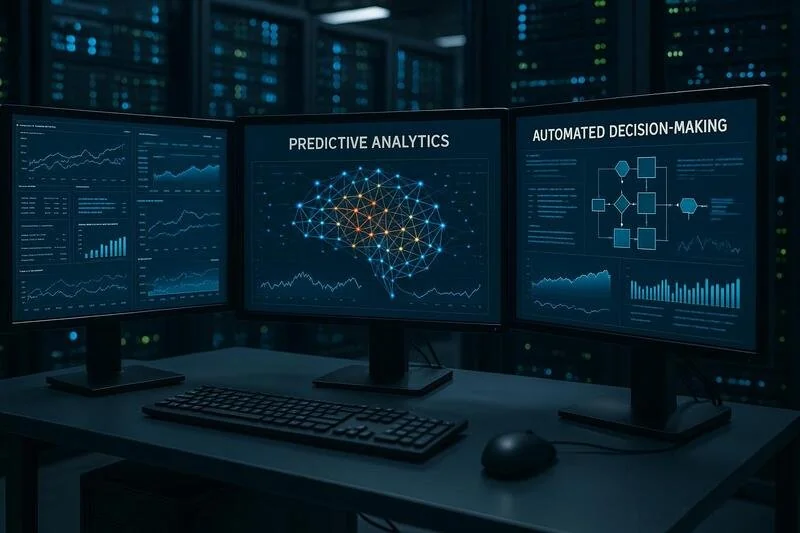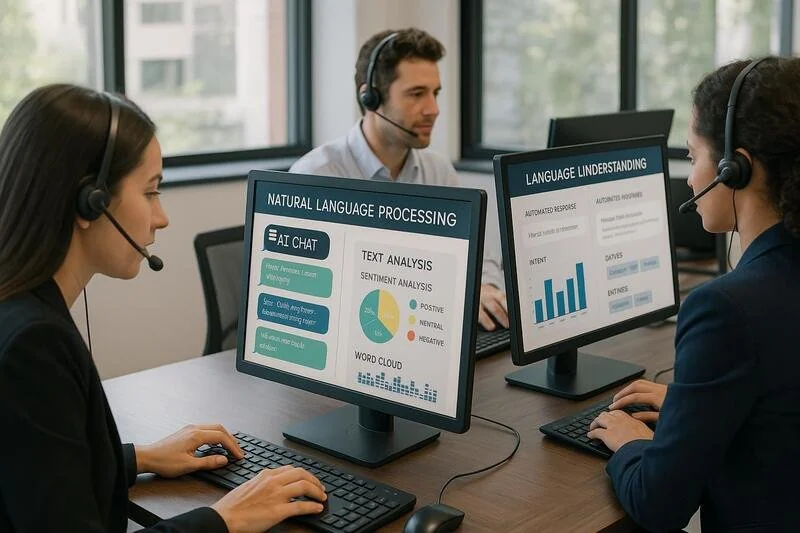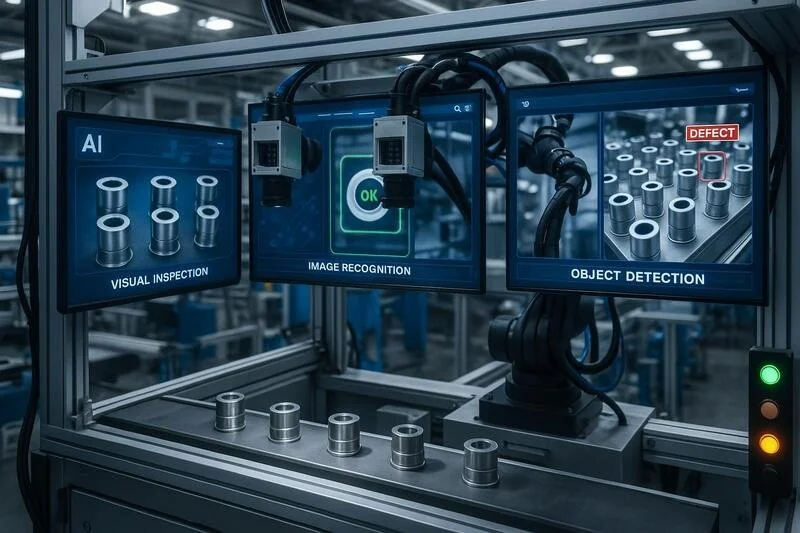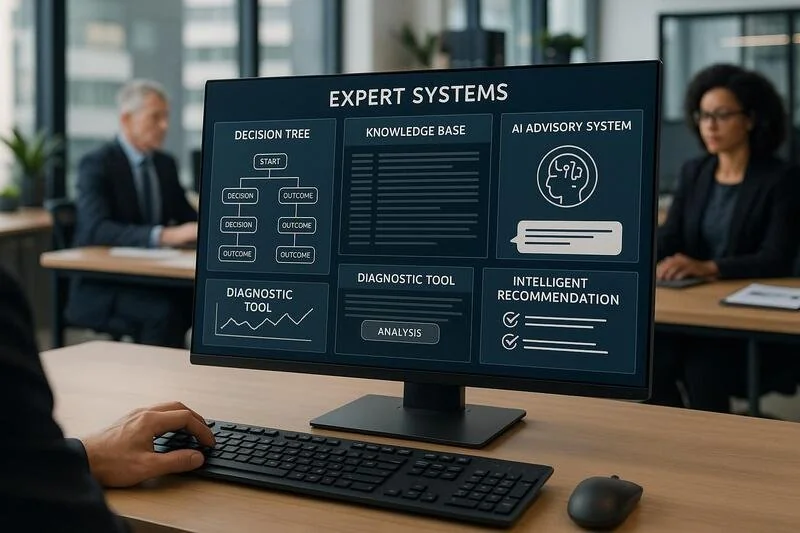¿Qué es la Automatización con IA?
La automatización con inteligencia artificial (IA) combina la potencia de los algoritmos de aprendizaje automático y otras tecnologías de IA con la automatización de procesos para crear sistemas capaces de realizar tareas complejas, adaptarse a nuevas situaciones y mejorar continuamente sin intervención humana constante.
A diferencia de la automatización tradicional, que sigue reglas predefinidas, la automatización con IA puede:
- Aprender de datos históricos y experiencias pasadas
- Adaptarse a situaciones nuevas o cambiantes
- Procesar y analizar grandes volúmenes de datos no estructurados
- Tomar decisiones basadas en patrones complejos
- Mejorar continuamente su rendimiento con el tiempo
- Realizar tareas que requieren percepción, razonamiento o juicio
Tecnologías de IA para Automatización
Machine Learning

Algoritmos que permiten a los sistemas aprender patrones a partir de datos y mejorar automáticamente con la experiencia, sin ser programados explícitamente para cada tarea.
Aplicaciones: mantenimiento predictivo, detección de fraudes, segmentación de clientes, optimización de precios, recomendaciones personalizadas.
Procesamiento de Lenguaje Natural

Tecnologías que permiten a las máquinas comprender, interpretar y generar lenguaje humano, facilitando la interacción entre personas y sistemas.
Aplicaciones: chatbots, análisis de sentimiento, clasificación de documentos, extracción de información, resumen automático, traducción.
Visión Artificial

Tecnologías que permiten a las máquinas "ver" y analizar imágenes o vídeos, identificando objetos, personas, texto y patrones visuales complejos.
Aplicaciones: control de calidad, reconocimiento facial, diagnóstico médico, conducción autónoma, análisis de imágenes satelitales.
Sistemas Expertos y Cognitivos

Sistemas que emulan la capacidad de toma de decisiones de un experto humano, utilizando bases de conocimiento y motores de inferencia para resolver problemas complejos.
Aplicaciones: diagnóstico médico, asesoramiento financiero, configuración de productos complejos, soporte técnico avanzado.
Beneficios de la Automatización con IA
Automatización Inteligente
Capacidad para automatizar tareas complejas que requieren juicio, adaptación y aprendizaje, superando las limitaciones de la automatización tradicional.
Mejora Continua
Los sistemas basados en IA mejoran automáticamente con el tiempo a medida que procesan más datos y aprenden de la experiencia.
Insights Predictivos
Capacidad para anticipar problemas, identificar oportunidades y predecir resultados basándose en el análisis de datos históricos y tendencias.
Optimización Avanzada
Optimización continua de procesos y recursos basada en múltiples variables y objetivos complejos que serían imposibles de gestionar manualmente.
Personalización a Escala
Capacidad para ofrecer experiencias y soluciones personalizadas a gran escala, adaptándose a las necesidades específicas de cada usuario o situación.
Ventaja Competitiva
Transformación digital avanzada que permite a las empresas diferenciarse, innovar más rápido y adaptarse mejor a los cambios del mercado.
Casos de Uso por Sector
Manufacturing
- Mantenimiento predictivo de maquinaria
- Control de calidad mediante visión artificial
- Optimización de cadenas de producción
- Gestión inteligente de inventario
Logistics
- Optimización de rutas y flotas
- Previsión de demanda
- Automatización de almacenes
- Gestión predictiva de la cadena de suministro
Retail
- Personalización de la experiencia de cliente
- Optimización dinámica de precios
- Gestión inteligente de inventario
- Análisis de comportamiento del consumidor
Servicios Financieros
- Detección de fraude en tiempo real
- Evaluación automatizada de riesgos
- Asesoramiento financiero personalizado
- Automatización de procesos de cumplimiento normativo
Atención Sanitaria
- Diagnóstico asistido por IA
- Personalización de tratamientos
- Optimización de recursos hospitalarios
- Monitorización remota de pacientes
Energy
- Optimización del consumo energético
- Mantenimiento predictivo de infraestructuras
- Gestión inteligente de redes eléctricas
- Previsión de producción de energías renovables
¿Cómo Implementar la Automatización con IA?
Identificación de Oportunidades
Análisis de procesos y áreas donde la IA puede aportar mayor valor, considerando la complejidad, el volumen de datos disponibles y el potencial impacto en el negocio.
Evaluación de Datos
Inventario y evaluación de la calidad, cantidad y accesibilidad de los datos necesarios para entrenar y alimentar los sistemas de IA.
Selección de Tecnologías
Evaluación y selección de las tecnologías de IA más adecuadas para los casos de uso identificados, considerando madurez, escalabilidad y requisitos específicos.
Desarrollo e Integración
Desarrollo o adquisición de soluciones de IA e integración con los sistemas y procesos existentes, asegurando la interoperabilidad y la seguridad.
Pruebas y Validación
Evaluación exhaustiva del rendimiento, precisión y fiabilidad de los sistemas de IA antes de su implementación completa en entornos de producción.
Despliegue y Monitorización
Implementación gradual de las soluciones de IA y establecimiento de sistemas de monitorización continua para evaluar su rendimiento y detectar posibles desviaciones.
Mejora Continua
Refinamiento y optimización constante de los modelos y sistemas de IA basándose en nuevos datos, feedback y cambios en los requisitos del negocio.